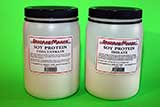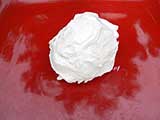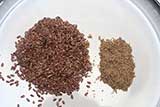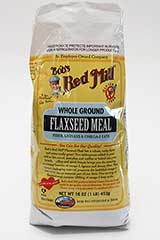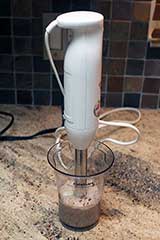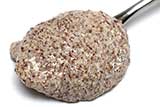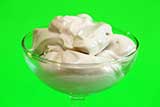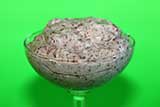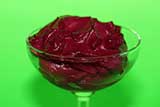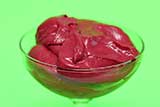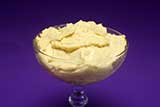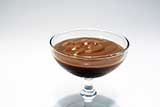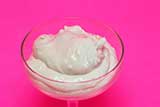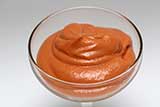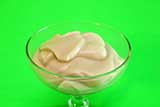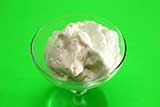Meats and Sausages
Emulsions
Reduced-Fat Sausages
Replacing animal fat with vegetable oil delivers good results, eliminates cholesterol, and lowers calories. It is not easy to manually mix oil with meat and some extra water. It often results in poor binding, and the texture may crumble. Using pre-mixed oil emulsion provides the best texture and is strongly recommended. Such an emulsion is easily made from soy protein isolate, vegetable oil, and water. It has a consistency of a soft cream cheese, it is a white gel that looks and tastes like fat. Oil emulsion is easy and fast to make and can be stored in a refrigerator for up to 5 days.
| Sausage, 100 g (3.5 oz) serving | ||
|---|---|---|
| Type and the amount of fat added | Meat | Total calories |
| Animal fat - 30% (30 g), 270 cal | lean pork, 70 g, 98 cal | 368 cal |
| Oil - 4% (4 g), 36 cal | lean pork, 70 g, 98 cal | 134 cal |
| Oil emulsion, 10% (10 g), 40 cal | lean pork, 70 g, 98 cal | 138 cal |
| Oil emulsion is a mixture of soy protein isolate, oil, and water. | ||
Replacing Fat with Protein/Oil/Water Emulsion
Preparing protein/fat/water emulsion is practiced by commercial producers. Such emulsion is kept in a cooler until needed. It is a very practical solution for making reduced-fat sausages. Think of it as a fat replacer that offers many advantages:
- It can be prepared in advance.
- Making emulsion is a clean and simple process.
- Its calorie content is well-defined.
- It does not include cholesterol.
- It preserves the original texture and mouthfeel of the sausage.
Oil emulsion is easy to administer, and its calorie content is precisely defined. A 100 g chunk of emulsion provides 398 calories; for comparison, one hundred grams of fat provides 900 calories, with cholesterol included.
| soy protein isolate/oil/water emulsion 1:4:5 |
|||
|---|---|---|---|
| 100 g | 200 g | 300 g | |
| SPI (92% protein) | 10 g (36.8 calories) | 20 g (73.6 cal) | 30 g (110.4 cal) |
| Vegetable Oil | 40 g (360 cal) | 80 g (720 cal) | 120 g (1080 cal) |
| Water | 50 g | 100 g | 150 g |
| Total Calories | 396.8 cal | 793,6 cal | 1190.4 cal |
Remember that:
- 1 g of fat or oil supplies 9 calories
- 1 g of protein supplied 4 calories
Generally, all professional recipes are calculated for 1000 g material (100%), so it is extremely easy to calculate the amount of emulsion. Ten percent of the emulsion is 100 g, twenty percent is 200 g, and so on. Let's assume that a recipe calls for 70% lean meat and 20% fat, the rest being water and other ingredients. Use 700 g of lean meat and 200 g of emulsion; that is simple. You don't need to add more water, as 1/2 of the emulsion is the water.
Note: the calculations below are based on the universally accepted norm that 1 g of protein supplies 4 calories. Soy protein isolate (SPI) used for making emulsion is 92% pure protein; thus, using 10 g of SPI will supply 36.8 calories (9.2 x 4 = 36.8 calories).
Let's see what happens when we make 1000 g (2.2 lb) sausage, but instead of using 200 g of fat, we replace it with an emulsion. The table above indicates that 200 g of fat supplies 1800 calories (200 x 9 = 1800), but adding 80 g of oil in the 200 g emulsion provides only 720 calories (80 x 9 = 720). The 20 g of protein in the emulsion adds an additional 73.6 calories (18.4 x 4 = 73.6). Thus, emulsion supplies around 800 calories (720 cal from oil plus 73.6 cal from protein = 793.6 cal) Thus, the net result of replacing 200 g of the fat with 200 g of the emulsion is the elimination of 1006 calories and all of the cholesterol from the sausage (1800 - 793.6 = 1006.4). This means we consume 100 calories less when consuming one portion of the sausage, which usually weighs about 100 g (3.5 oz)
Soy protein concentrate (SPC, 70% protein); commonly added to homemade sausages, produces a yellowish paste instead of a clear emulsion. Soy protein isolate (SPI, 90% protein) produces the real gel: a white, soft, cream cheese-like substance that tastes like fat. Soy protein concentrate (SPC) produces a yellowish paste at best. In addition, SPC will not even make a paste when used at 1:4:5 (SPC : oil : water) ratio. The amount of SPC has to be increased and the final product is still a paste.Soy protein isolate is an almost pure protein with very few impurities, and that is why it makes such a great emulsion.Although SPI is slightly more expensive than SPC, it is used in such a small amount that the price should not be the decisive factor.
Why Do We Need Emulsion?
All sausages need fat. Fat carries flavor and provides a pleasant mouthfeel. Animal fat works great as it solidifies at room temperature. Melt animal fat, add finely chopped dry meat and berries to it and you will get the great Indian snack called Pemmican. It is rock-hard and will last years without refrigeration. You cannot do it with oil.
Oil is liquid when heated and remains liquid when cold. You can add 50% of pork fat to the sausage, and its texture will be fine. When more than 5% of vegetable oil is added to vegetarian sausage, we get problems. The sausage is oily and soft, and oil pockets appear. It gets under the skin of the casing. and we get oily fingers trying to remove the casings.
We can hide oil inside the emulsion, and it will be neither seen nor sensed. The emulsion can hold a very large amount of oil. Take, for example, an egg emulsion, commonly known as mayonnaise. It is basically the yolk of an egg plus plenty of oil. Some salt, mustard, vinegar, this hardly counts at all. Yet this huge amount of oil looks pretty and tastes great.
The emulsion consists of an emulsifier, fat (or oil), and water. We know that oil and water do not mix. but they will in the presence of an emulsifier such as liver, yolk of an egg or a rich source of vegetable protein like soy protein isolate. Flaxseed is another great natural emulsifier.
Most food emulsions are known as the oil-in-water type, which means that oil (or fat) droplets are dispersed throughout the water. Put oil and water in a jar, shake it well, and you’ll disperse the oil. After a while, the oil droplets will coalesce together and the layer of oil will be on top of the water. We need a substance known as an emulsifier to disperse oil in water and prevent the oil droplets from coming together.
Protein is needed to mix substances such as fat and water. Proteins are released from muscles during cutting or grinding. Salt and phosphates facilitate the release of proteins. Protein dissolves in salt and water and creates a liquid that coats each fat particle with a thin layer of soluble protein. Those coated fat particles combine with water and meat, and the emulsion is created. The leaner the meat, the more protein it contains. If little or no fat is used, there will not be any real emulsion, but the proteins will hold the texture of the sausage together.
Vegetarian sausages do not contain meat, so we use a material rich in protein, such as soy protein isolate (90% protein) or flaxseed. The latter contains about 42% protein but is a wonderful emulsifier that produces quite a sticky emulsion.
Vegetable Protein Emulsions
Vegetarian sausages do not contain meat proteins; however, vegetable proteins can produce stable emulsions, augment the nutritional value of sausage, and eliminate cholesterol. The protein covers oil particles with a protein film, and then oil and water mix together, creating a true emulsion. Such emulsion looks, feels, and tastes like fat, helps to achieve a better texture, and provides plenty of protein and calories but none of the cholesterol. And it mixes well with all other ingredients.
Emulsifiers
Emulsifiers are essential in order to mix fat and water in foods. The principal ingredients of the emulsion are emulsifier, fat, and water. The emulsifier contains proteins plus a significant amount of mucilage, which is a mixture of gluey and gelatinous substances that form a matrix with fat particles and water droplets. Popular emulsifiers:
- Meat protein
- Milk protein (caseinate)
- Egg yolk
- Vegetable protein (soy protein or flaxseed)
Egg yolk contains many proteins that act as emulsifiers; the most important is lecithin which prevents the surface of the fat droplet from coming into contact with the surface of another fat droplet. This is why egg yolks are important in making foods such as hollandaise sauce and mayonnaise.
Sodium caseinate, a milk protein, is an excellent emulsifier that was commonly used to stabilize fat and water emulsions. Caseinate can emulsify different types of fats from different animals. However, the price of milk proteins was increasing and soy proteins took over the dominant spot. Caseinate is about 90% protein and is added at 1-2% per kg of meat. Milk protein will lighten up the sausage and will make it slightly softer. It is added to meat batter as a dry powder or as prepared emulsion. The emulsion is usually set at milk protein/fatty trimmings/water in the ratio of 1:5:5.
Note: Many vegetarians do not accept milk protein and egg yolk in their vegetarian diet.
Two emulsifiers of special interest for making vegetarian sausages are:
- Soy protein
- Flaxseed
If flaxseed or soy protein are mixed together with other ingredients in one step, the ingredients will separate. If flaxseed or soy protein emulsion is created first, then the emulsion will hold other ingredients together. If little or no fat is used, there will not be any real emulsion, but the proteins will bind the ingredients together.
Soy Protein Emulsion
Soy protein emulsion is easily made from soy protein isolate, vegetable oil and water. It has a consistency of a soft cream cheese, it is a white gel that looks and tastes like fat. Soy emulsion is easy and fast to make and can be stored in a refrigerator for up to 5 days.
Soy protein isolate (SPI, 90% protein) produces the real emulsion gel: a white, soft, cream cheese-like substance that tastes like fat. Soy protein isolate is an almost pure protein with very few impurities, and that is why it makes such a great emulsion.
SPI is water-hungry, so it is difficult to start an emulsion with less than 5 parts of water. Once SPI and water are mixed into a paste 4 or more parts of oil can be added.
| soy protein isolate/oil/water 1 : 4 : 5 |
|
|---|---|
| SPI (92% protein) | 10 g |
| Vegetable oil | 40 g |
| Water | 50 ml |
| Emulsion total: | 100 g |
| Calories | 398 cal |
Making Emulsion
- Using a food processor/blender or manual whisk, start cutting cold water with soy protein isolate until a shiny paste is obtained. This takes about one minute.
- Add chilled oil and cut at high speed until a stable emulsion is obtained. It should take about 2 minutes.
- Store emulsion for up to 5 days in a refrigerator.
Flaxseed
Flaxseed is a very nutritious and rich in fiber seed that is often used as an emulsifier in the baking industry.
| Flaxseed Nutrient Values (100 g) | |||||
|---|---|---|---|---|---|
| Name | Protein (g) | Fat (g) | Carbohydrates (g) | Cholesterol (g) | Energy (cal) |
| Flaxseed | 18.29 | 42.16 | 28.88 | 0 | 534 |
| Source: USDA Nutrient database | |||||
Flaxseed has a sufficient amount of gelatinous substances for forming suitable emulsions.
The following ratios will produce suitable emulsions:
- Flaxseed, 3-10%
- Vegetable oil, 60-80%
- Water, 10-30%
The fat can be of animal or vegetable nature; corn, sunflower or olive oil is suitable.
Making Flaxseed Emulsion (1:3:3)
10 g ground flaxseed: 30 ml water: 30 ml oil
Flaxseed must be milled to the smallest particle possible. The labor-consuming process of grinding seeds can be eliminated by buying milled seeds in a supermarket.
Blend milled flaxseed with water on medium speed until a paste is obtained. Start adding oil and blend all together at high speed. Blend until a uniform texture is obtained without any pockets of oil, water, or flax.
Soy protein emulsion is almost neutral in flavor, very smooth, and white in color. Best for creamy texture sausages where the uniform color is desired.
Emulsions can be made with milk caseinate or whey protein, however, these proteins do not meet vegan standards. Whey protein is made by drying liquid whey which is a byproduct obtained during cheese making. Similarly to soy products, whey protein comes as:
- Whey protein concentrate, 30-89% protein.
- Whey protein isolate, 90% or more.
Whey is essential in the bodybuilding world today because of its ability to be digested very rapidly.
The following two emulsions work very well in vegetarian sausages:
| Emulsion | Protein | Oil | Water |
|---|---|---|---|
| Soy protein (100 g) | 10 g | 40 g | 50 g |
| Flaxseed (50 g) | 10 g | 20 g | 20 g |
| Flaxseed (100 g) | 20 g | 40 g | 40 g |
Colored and Flavored Emulsions
The secret for making high-quality emulsion is very simple: replace water, which has no taste, with a liquid of your choice, such as vegetable broth or juice. The resulting emulsion will have a different flavor and color.
You can make your broth by boiling soup greens or buy ready-to-use commercially made vegetable broth, which may even be flavored, for example, vegetarian beef broth. The simplest solution is to use vegetarian bouillon cubes.
Flavored Soy Emulsions
Adding soy sauce to soy emulsion produces a unique miso-like flavored product. Miso is a traditional Japanese thick paste produced by fermenting soybeans with salt and fungus. Miso is used for sausces and spreads, pickling vegetables or meats, and making miso soup, a Japanese culinary staple.
- 10 g soy protein isolate
- 40 ml oil
- 20 ml soy sauce mixed with 30 ml of water
Do not increase the amount of soy sauce. The emulsion can be combined with seaweeds like nori to make a vegetarian fish sausage.
Customized emulsions can be designed to suit a particular application. For example replacing water with tomato juice creates soy protein tomato emulsion.
Flaxseed coconut emulsion can be made with 1 part ground flaxseed and 7 parts of coconut milk without additional oil needed.
Soy Protein Paste
Soy protein concentrate (SPC, 70% protein) is commonly added to homemade meat sausages but will not produce an emulsion, just a paste which looks like an emulsion. It is not as smooth as emulsion, it is somewhat grainy so you will not use it in applications like ice cream or fine yogurt. It is perfectly acceptable to make sausages of any kind. SPC needs only 3 parts of water, the amount of oil can vary from 2 parts to more.
- A typical SPC paste (1:3:3):
- 10 g SPC: 30 ml oil: 30 ml water.
Vegan Mayonnaise
By now you might have discovered that a soy emulsion is basically a vegan mayonnaise, all you need to add is some salt, vinegar and mustard powder (or prepared mustard).
Expensive vegan mayonnaise is nothing else than a spiced-up protein emulsion that you can make yourself.
There are many ways to make eggless mayonnaise. Most recipes call for blending whole milk and lemon juice. As milk does not really conform to vegan requirements, other recipes include soy milk, oil, lemon juice, and different seasonings.
Soy Protein Mayonnaise
- Soy protein isolate, 20 g
- Water, 100 ml
- Oil, 125 ml
- Salt,
- Lemon juice, 2 tsp
- Prepared mustard, 1 tsp
- Blend SPI with water and lemon juice.
- Gradually add oil and blend together.
- Add salt, mustard and seasonings of your choice and blend together.
Soy Milk Vegan Mayonnaise
Soy milk makes wonderful, white, and easy-to-produce mayonnaise. Taste soy milk first as even traditional original soy milk made by different manufacturers exhibits different flavors. Some milk tastes beany while other is sweet, those flavors may be present in a finished product.
- Soy milk, 120 ml (1/2 cup)
- Canola oil, 250 ml (1 cup)
- Lemon juice, 2 tsp
- Pinch of salt
- Prepared mustard, 1 tsp
- Blend soy milk with lemon juice.
- Add oil and blend.
- Add salt and mustard and blend all together.
Add ketchup, and you will create Russian dressing, which may become a part of a vegetarian tomato sausage. Add ketchup and creamy horseradish sauce, and you will create a cocktail sauce.
Emulsions and mayonnaise can be very useful for making sausages. The main benefit they offer in making vegetarian sausages is their ability to bind and hold the oil inside.
Note: all emulsion ratios are by weight, for example soy protein emulsion (1:4:5) is made by blending 10 g soy protein with 40 g oil and 50 g water. Protein is mixed with water first, and then oil is added.
Vegetarian sausage recipes are listed in the Sausage Recipe Index


